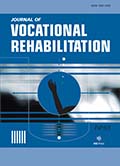Authors: Kim, Jaeyoung | Park, Sara | Castruita-Rios, Yazmin | Weathers, Marcus | Park, Mirang | Inge, Katherine | Riesen, Tim | Keeton, Beth | Avellone, Lauren | Tansey, Timothy
Article Type:
Research Article
Abstract:
BACKGROUND: Customized employment (CE) is positively correlated with competitive integrated employment (CIE) outcomes and potentially supports transition-age youth in achieving sustainable employment. OBJECTIVE: This study examines the employment outcomes and related factors for transition-age youth with disabilities who received CE services through state vocational rehabilitation agencies (SVRAs) and their vendors from program year 2017 to 2020. METHODS: Employing a combination of descriptive analysis, binary logistic and multiple regression, chi-square tests, and t -tests, the study investigates the demographics, potential barriers, and vocational rehabilitation (VR) services received by the research sample using the RSA-911
…dataset. RESULTS: The sample comprised 672 individuals with a mean age of 22.30 years. The most prevalent barrier to employment among CE participants was long-term unemployment, while Supplemental Security Income (SSI) was the most common social security benefit. Furthermore, only 13.2% of transition-age youth achieved CIE status, compared to 30.1% of adults. The key predictors of employment outcomes, including CIE status, weekly earnings, and working hours were identified. CONCLUSION: The research reveals significant differences in employment outcomes between transition-age youth and adult VR consumers. These insights emphasize the necessity for SVRAs to consider a range of factors, including demographics, potential employment barriers, and the effects of various VR services, to increase the CE service effectiveness for transition-age youth.
Show more
Keywords: Customized employment, transition-age youth, vocational rehabilitation, competitive integrated employment, individuals with significant disabilities
DOI: 10.3233/JVR-240013
Citation: Journal of Vocational Rehabilitation,
vol. 60, no. 3, pp. 281-297, 2024





